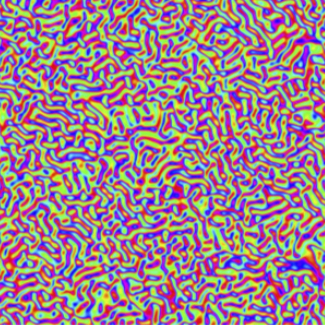Apr 3 2020
Turbulent flows exhibit versatile statistical properties despite being chaotic. In the last few years, turbulent flows have been identified in active fluids like epithelial cell monolayers, mixtures of biopolymers and molecular motors, and bacterial suspensions.
 Disordered pattern of eddies of a characteristic size. The color code indicates the local orientation of the liquid crystal. Image Credit: University of Barcelona.
Disordered pattern of eddies of a characteristic size. The color code indicates the local orientation of the liquid crystal. Image Credit: University of Barcelona.
Scientists from the University of Barcelona, Princeton University, and Collège de France have demonstrated that the chaotic flows in active nematic fluids are explained by unique universal scaling laws. The findings of their study have been reported in the Nature Physics journal.
Turbulence is omnipresent, right from air flows caused by an airplane, through large-scale oceanic and atmospheric flows on Earth, to plasma flows in stars. Found to be chaotic, turbulent flows form eddies that emerge and break into tiny swirls consistently.
But when this complicated chaotic behavior is examined in a statistical sense, universal scaling laws are obeyed by turbulence. This implies that the statistical properties of turbulence are independent in the way turbulent flows are produced, as well as in the properties of the particular fluid that has been observed, such as its density and viscosity.
Scientists have re-investigated this concept of universality in the context of active fluids. In the case of active turbulence, eddies and flows are not produced by the action of an external agent (like temperature gradients in the atmosphere) but by the active fluid itself.
The active nature of these fluids depends on their potential to produce forces internally, for instance, due to the action of molecular motors on biopolymers or the swimming of bacteria.
When these active forces are sufficiently strong, the fluid starts to spontaneously flow, powered by the energy injected by the active processes.
Ricard Alert, Postdoctoral Fellow, Princeton University
While active forces of the fluid are powerful, such spontaneous flows turn out to be a chaotic blend of self-generated eddies—the so-called active turbulence.
The focus of the researchers was on a specific type of active fluid—two-dimensional active nematic liquid crystals—which explain experimental systems like suspensions of biopolymers and molecular motors and cell monolayers.
Through large-scale simulations, it was found that the active flows arrange into a disorganized pattern of eddies of a characteristic size. Furthermore, the scientists investigated the flows at considerably larger scales compared to the characteristic size of the eddies. They identified that the statistical properties of these large-scale flows obey a unique scaling law.
We showed that this scaling law is universal, independent of the specific properties of the active fluid.
Jaume Casademunt, Professor, Institute of Complex Systems, University of Barcelona
This scaling law for active nematic fluids is similar to Andrei Kolmogorov’s 1941 scaling law for classic turbulence. However, it includes a different component that is the result of the combination of inertia-less viscous flows and the internal, self-organized forcing of active fluids.
One more remarkable outcome of this study is that all the energy exerted by the active forces at a specified scale is dissipated by viscous effects at that same scale. As a result, contrary to classic turbulence, no energy is left to be shifted to other scales.
Both in simulations and analytically, researchers proved that a minimal active nematic fluid self-organizes in a way such that the active energy injection exactly balances energy dissipation at each scale.
Jean-François Joanny, Researcher, Collège de France